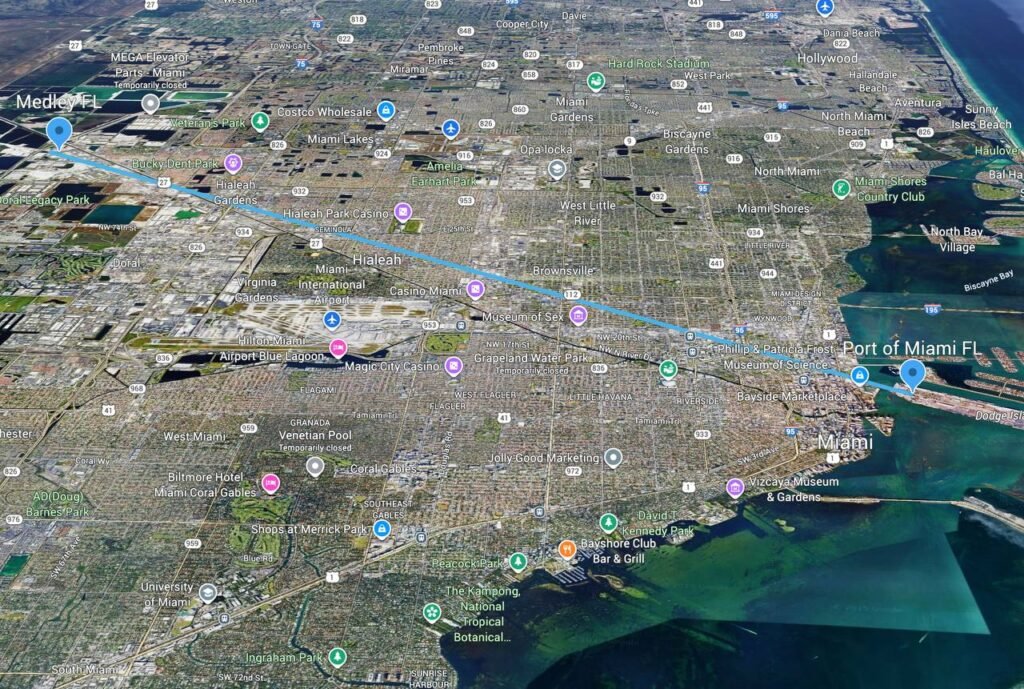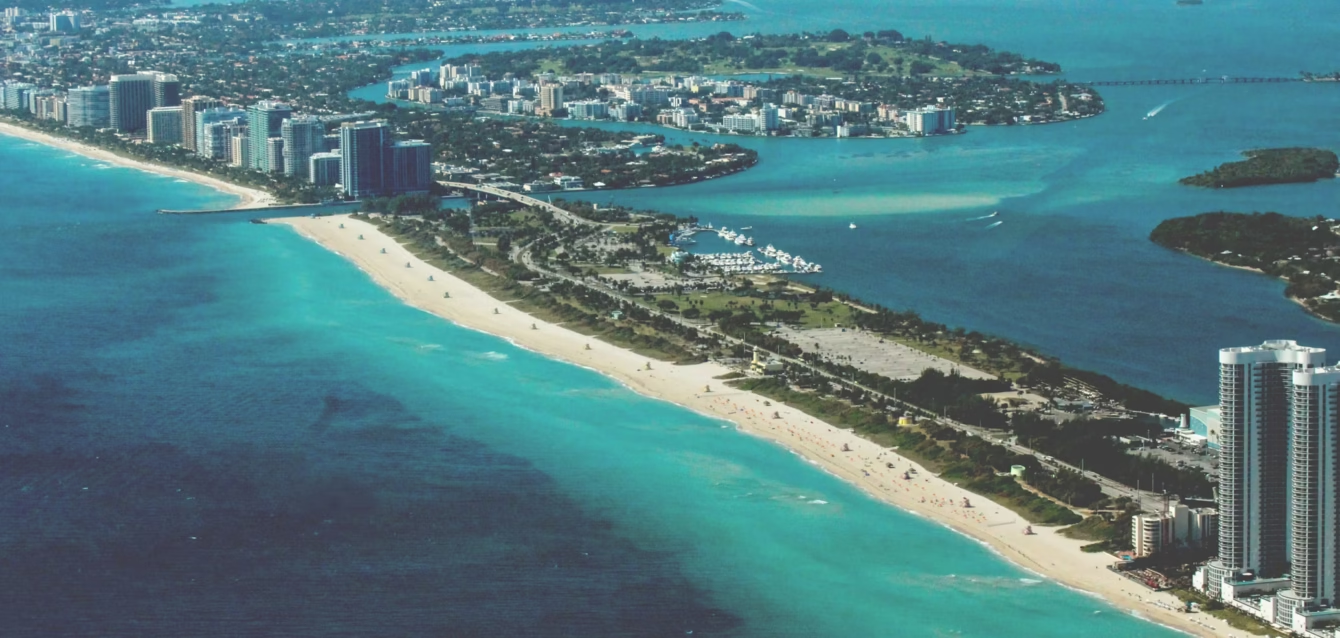Executive Summary
Miami, Florida, stands at a critical crossroads. With its population projected to surge by over 700,000 residents by 2050—reaching approximately 3.47 million in Miami-Dade County—this vibrant city faces an urgent threat from unchecked growth that could cripple its outdated transportation infrastructure, escalate economic losses, and degrade quality of life. Without bold action, escalating traffic congestion, inefficient trucking, and archaic systems could cost the city billions annually in lost productivity, health impacts from emissions, and stalled economic progress. However, the American Dream Rail system emerges as a game-changing, scalable solution: a high-speed, elevated rail network connecting the Port of Miami to a new distribution center in Medley, just 19 miles away. Fully operational by 2035 and funded through a $5.5 trillion national legacy project, this system promises to slash freight costs by 50%, cut delivery times in half, and reduce emissions by 75%, all while generating revenue for the city through an innovative air-use tax.
Our analysis reveals stark contrasts: Before implementation, projected growth could burden the city with $10-15 billion in infrastructure upgrades, add $3.1 billion yearly in congestion costs, and diminish Florida’s Gross State Product (GSP) growth by 0.5-1% annually due to inefficiencies. After, savings could exceed $200 million yearly in freight alone, with social benefits like fewer accidents and cleaner air boosting community well-being. This isn’t just infrastructure—it’s a lifeline for Miami’s prosperity, ensuring the city thrives as a global hub. By embracing American Dream Rail, Miami can turn crisis into opportunity, fostering sustainable growth that benefits every resident and business.

Introduction
Imagine a Miami where goods flow seamlessly from port to market without gridlocked highways, where families reclaim hours lost to traffic, and where the air is cleaner for generations to come. Yet, as Florida’s population booms—adding thousands daily—this vision risks fading under the weight of outdated roads and inefficient trucking. This case study urgently examines Miami’s projected population surge to 2050 and its profound impacts on transportation of citizens and goods. We delve into the “before” scenario: escalating burdens on an obsolescent infrastructure, soaring costs, and dire social consequences. Then, we pivot to the “after”: how the innovative American Dream Rail system revolutionizes efficiency, cuts emissions, and unlocks economic potential.
Drawing on data from state projections, economic analyses, and transportation studies, we compare costs and savings with and without the rail, highlighting new needs, shortfalls, and opportunities. Our optimistic lens underscores that with visionary solutions like Dream Rail, Miami can not only survive growth but soar—creating jobs, saving billions, and preserving its sunny allure. The urgency is clear: act now, or pay dearly later.
Background Information
Miami-Dade County, home to the bustling Port of Miami, is an economic powerhouse fueled by tourism, trade, and innovation. Currently, the county’s population hovers around 2.77 million (2023 estimate), but rapid influxes from migration and natural growth are accelerating. Florida as a whole is projected to add 1,000 residents daily through 2050, with South Florida (including Miami-Dade) expecting a 14% rise, pushing Miami-Dade toward 3.47 million by extrapolating medium projections from the Bureau of Economic and Business Research (BEBR) . This marginal growth—roughly 700,000 additional people—amplifies pressure on transportation, where roads handle millions of daily commuters and the port moves 10.1 million short tons of container freight annually.
Current infrastructure is alarmingly inadequate: Miami ranks among the world’s most congested cities, with drivers losing 74-105 hours yearly to traffic. Trucking, vital for port operations, is inefficient and poorly managed, contributing to obsolescent roads and archaic systems. Florida’s GSP, currently over $1.4 trillion, grows at 2.2-2.4% annually but faces headwinds from congestion, which already costs urban areas like Miami $3.1 billion yearly in lost time and fuel.
Emissions from transportation account for 55% of county-wide greenhouse gases, exacerbating health and environmental risks. Amid this, the American Dream Rail system offers a beacon of hope. This elevated, scalable rail network—designed for passenger and freight—will link the Port of Miami to a new distribution center in Medley, 19 miles away, functioning as a port extension. Funded by the $5.5 trillion American Dream Rail legacy project, it promises to bypass road woes without disrupting city life or security.
Problem or Challenge
Miami’s projected population boom to 3.47 million by 2050 isn’t just numbers—it’s a ticking time bomb for transportation, threatening economic vitality and social harmony. Without intervention, this growth will amplify inefficiencies in moving citizens and goods, leading to cascading crises.
○ New Essential Needs for the City and People:
Expanded Road and Transit Capacity: To accommodate 700,000 more residents, Miami needs upgraded highways, public transit expansions (e.g., SMART Plan corridors), and smart traffic systems to handle 20-30% more vehicles.
Freight Optimization: With port freight steady at 10.1 million short tons, growth demands efficient alternatives to trucking, reducing reliance on congested routes like I-95.
Sustainable Mobility: Residents require low-emission options to combat rising pollution, including electric vehicle infrastructure and bike/pedestrian networks.
Resilient Infrastructure: Climate risks like sea-level rise necessitate elevated or flood-proof systems.
○ Breakdown of Projected Costs to the City:
Infrastructure Upgrades: Florida’s statewide needs top $66 billion over five years, with Miami-Dade requiring $10-15 billion by 2050 for roads, bridges, and transit expansions (e.g., $7.5 billion in current TIP priorities scaling up).
Maintenance and Operations: Annual costs could rise to $2-3 billion, including $381 million for bridges and $1.9 billion for resurfacing, adjusted for growth.
Emission Mitigation: Investing in green tech adds $500 million-$1 billion, per decarbonization studies.
○ Cost to Individual Households:
Direct Expenses: Households may face $1,000-2,000 more annually in taxes/fees for infrastructure bonds and tolls.
Indirect Burdens: Congestion costs $1,325-$1,700 per driver yearly in time/fuel, plus $14,400+ in overall transportation spending—highest in the U.S..
Health and Productivity: Pollution-linked illnesses add $500-1,000 per family in medical costs.
○ Projected Shortfalls from Anticipated Limitations :
Funding Gaps: State budgets allocate $15.5 billion for FDOT, but local shortfalls could reach $5-7 billion by 2050 due to competing priorities like resilience.
Capacity Limits: Without upgrades, roads hit 30% more congestion, exceeding design limits.
Resource Constraints: Labor shortages and material costs inflate projects by 20%.
○ Potential Consequences for Failing to Meet Shortfalls:
Economic Stagnation: Untamed congestion could shave 0.5-1% off Florida’s GSP growth, reducing the projected 2.2% annual rate and costing $10-20 billion cumulatively by 2050.
Social Strain: Increased accidents (from truck traffic), health issues (807 avoidable deaths from emissions), and inequality—low-income areas suffer most.
Environmental Toll: Emissions rise 20-30%, with trucking contributing 59% of NOx; health costs hit $8.9 billion.
○ Effect on Gross State Product (GSP):
Florida’s GSP, projected to grow at 2.2% annually to ~$3 trillion by 2050, could falter: Congestion erodes productivity, potentially lowering growth to 1.5-2%, a $100-200 billion loss statewide.
○ Cost of Increased Emissions:
Trucking and traffic could add $5-10 billion in health/economic damages by 2050, with 55% of GHG from transport fueling climate impacts.
Solution or Approach
Enter the American Dream Rail: a revolutionary, elevated rail system that flies over congestion, transforming Miami’s freight and passenger transport. By relocating processing to Medley, it matches inbound/outbound freight efficiently, slashing port dwell times and passing 50% cost savings to industries. Benefits include:
Flying over traffic, delays, detours, or closures.
Reducing truck traffic on roads.
Eliminating accident risks.
Cutting goods transport costs by 50% (to $0.06/ton-mile).
Halving delivery times.
Slashing emissions by 75%.
Capturing 50% of port freight (5.05 million short tons), it generates ~$5.76 million in annual revenue at $6 per 100-ton mile. The city receives an air-use tax of 16% x $6.00 per 100-ton mile (equating to ~$921,000 yearly from revenue), funding local needs.
Compare/Contrast Before and After:
- Costs: Before—$3.1B/year congestion + $10-15B upgrades; After—Savings of $100-200M in freight (50% cut on ~$11.5M current trucking costs) + reduced maintenance ($1-2B long-term).
- Savings Differentials: Without rail, emissions cost $5-10B by 2050; with, 75% reduction saves $3.75-7.5B. Time savings: 50% faster deliveries reclaim 50-100 hours/driver annually.
- Economic Impact: Before—GSP drag of 0.5-1%; After—Boost via efficiency, adding 0.2-0.5% growth (~$50B cumulative).
- Social Impact: Before—Accidents, pollution harm communities; After—Safer roads, cleaner air prevent 600+ deaths, enhance equity.
Implementation
Rollout begins now for 2035 full capacity: Construct 19-mile track ($1.33 billion) and 29 vehicles ($4.35 million), funded nationally. Daily ops: 13,836 short tons, vehicles spaced 2.65 miles at 55 mph, every 23 minutes. Scalable for passengers, it integrates without disrupting life—elevated design ensures security. Monitor via pilots, adjust for growth. With urgency, Miami can lead: Invest today for a thriving tomorrow.
#SignForAmericaLet’s make America unstoppable.
Sign the petition today for your sake, more so than President Trump’s.
Phone Numbers
Work: +1 (305) 000-0000
Support: +1 (888) 000-0000
Our Location
Work: +1 (305) 000-0000
Support: +1 (888) 000-0000
American Patriots, Inc., c/- dba: American Dream Rail Legacy Project
Miami FL, 33127
contact@AmericanDreamRail.com



